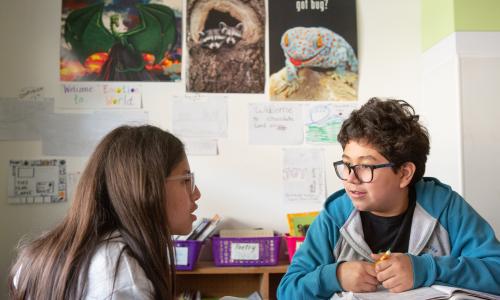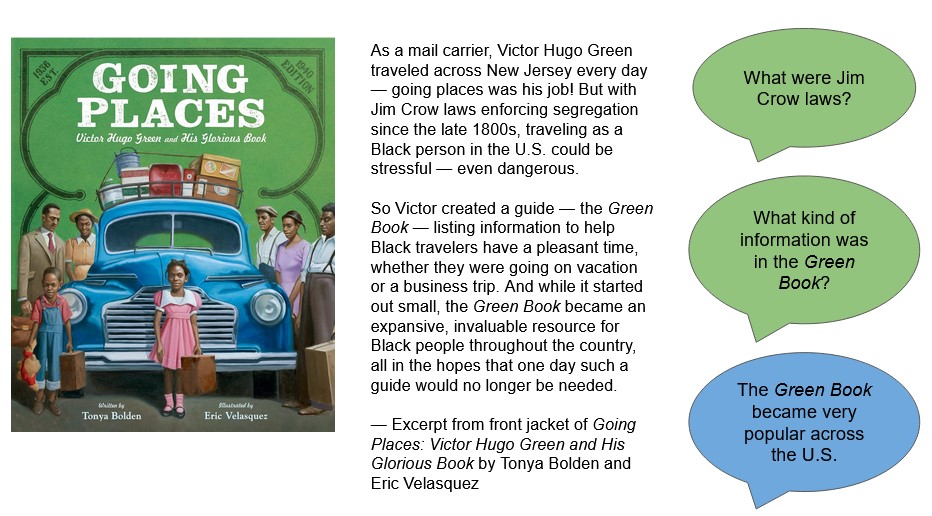
In this protocol, students work together to synthesize their collective understanding of the text. This strategy is part of Colorin Colorado's ELL Strategy Library and can be used to support academic language development for all students.
Photo by Allison Shelley for EDUimages
Strategy Overview
How This Strategy Supports Language Development
Reading collaboratively with a partner can foster greater comprehension of academic texts because students can pool their understanding to form meaning. Each partner has a role as they work together to foster comprehension about small segments of text by making notes, summarizing, asking questions, and discussing the text.
Step-by-Step Instructions
- Students work in pairs or triads.
- One student starts by reading a paragraph aloud.
- After each paragraph or short chunk of text, the group pauses to collaboratively derive the meaning of that paragraph. The listening partners begin by asking questions, making connections, or making a comment about that passage.
- Once they agree, the group writes down the summary or a question as an annotation.
- The next paragraph is read by another student and the process continues.
Lessons Learned
- Modeling is essential for the success of this protocol. Model the first two paragraphs with students' help to demonstrate the protocol.
- Teach students to synthesize in their own words so that they demonstrate understanding.
- Consider whether your students would benefit from assigned roles, at least when first using the strategy. Make sure students understand the responsibilities of each role.
- Encourage the listening partner to begin the discussion. Because the reader is focusing on pronouncing the words, they may need more processing time to make meaning of the text.
- Instruct students to adhere to the procedure, which is more collaborative as students are free to contribute in any way they can. Encourage them to ask questions and make connections in addition to simply summarizing the text.
- Stop the class after they have read a few paragraphs or chunks of text collaboratively. Check in on their comprehension so far and then have them return to their collaborative reading protocol.
Read, Think, Take Note
You may wish to use some of the instructions detailed in some of the science unit exemplars featured on the Next Generation Science Standards website. This strategy is called "Read, Think, Take Note" and this list is featured in a middle school lesson plan on disrupting ecosystems.
As you read, stop at least three times to write one of the following:
- Explain a thought or reaction to something you read.
- Note something in the reading that is confusing or unfamiliar.
- Identify a word that you do not know.
- Describe a connection to something you learned or read previously.
- Make a statement about the reading.
- Ask a question about the reading.
Differentiation
Entering/Emerging
- Beginning level students can still participate in the protocol with a text closer to their reading level or a text in their heritage language.
- Encourage beginners to discuss the text in their heritage language.
- Join a team of beginning level students to guide them through the protocol.
- Encourage students to read and annotate one sentence at a time.
Developing
- Give students more text in each chunk (a paragraph or two).
- Encourage students to engage with the text beyond summarization by making connections and asking questions.
Expanding
- Ask students to share their annotations with the class as a model.
- Ask students to read longer chunks of text before processing with their partner.
Co-Teaching Considerations
Content or Grade-Level Teacher
- Choose the passage students should read in class using the collaborative reading protocol.
- Determine the essential understandings students should gain from the reading.
English Language Development Teacher
- Purposefully partner students for the collaborative reading protocol based on reading level, heritage language, and English language development level.
- Provide scaffolds for the discussion (question starters, summary starters, etc.).
- Monitor students' ability to follow the protocol so that everyone contributes to forming meaning.
- Work with a small group, if necessary.
- Have students explain how they can use this protocol in another class.
Examples
 |
Resources
- Partner Reading Bookmarks (Exc-ELL)
- Strategy & Video: Partner Reading (Reading Rockets)
- Strategy: Collaborative Strategic Reading (CSR) Strategy (AdLit.org)
- Collaborative Annotation (Tan Huynh)
- Collaborative Reading: Building Successful Readers Together (Edutopia)
- Collaborative Strategic Reading (CSR): A Comprehension Strategy to Enhance Content Area Learning (Edutopia)
- CSR: A Comprehension Reading Strategy (IRIS Center)


